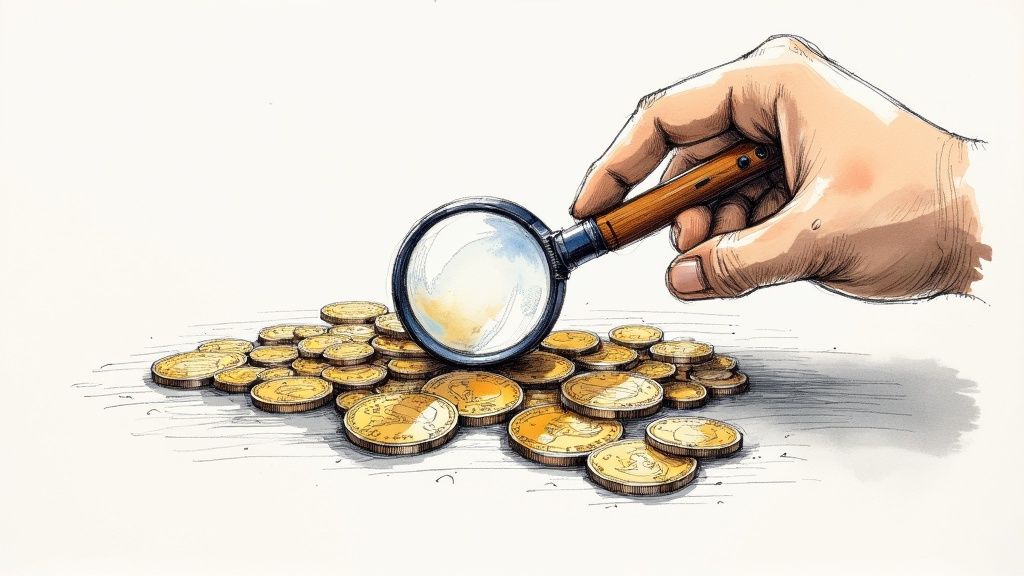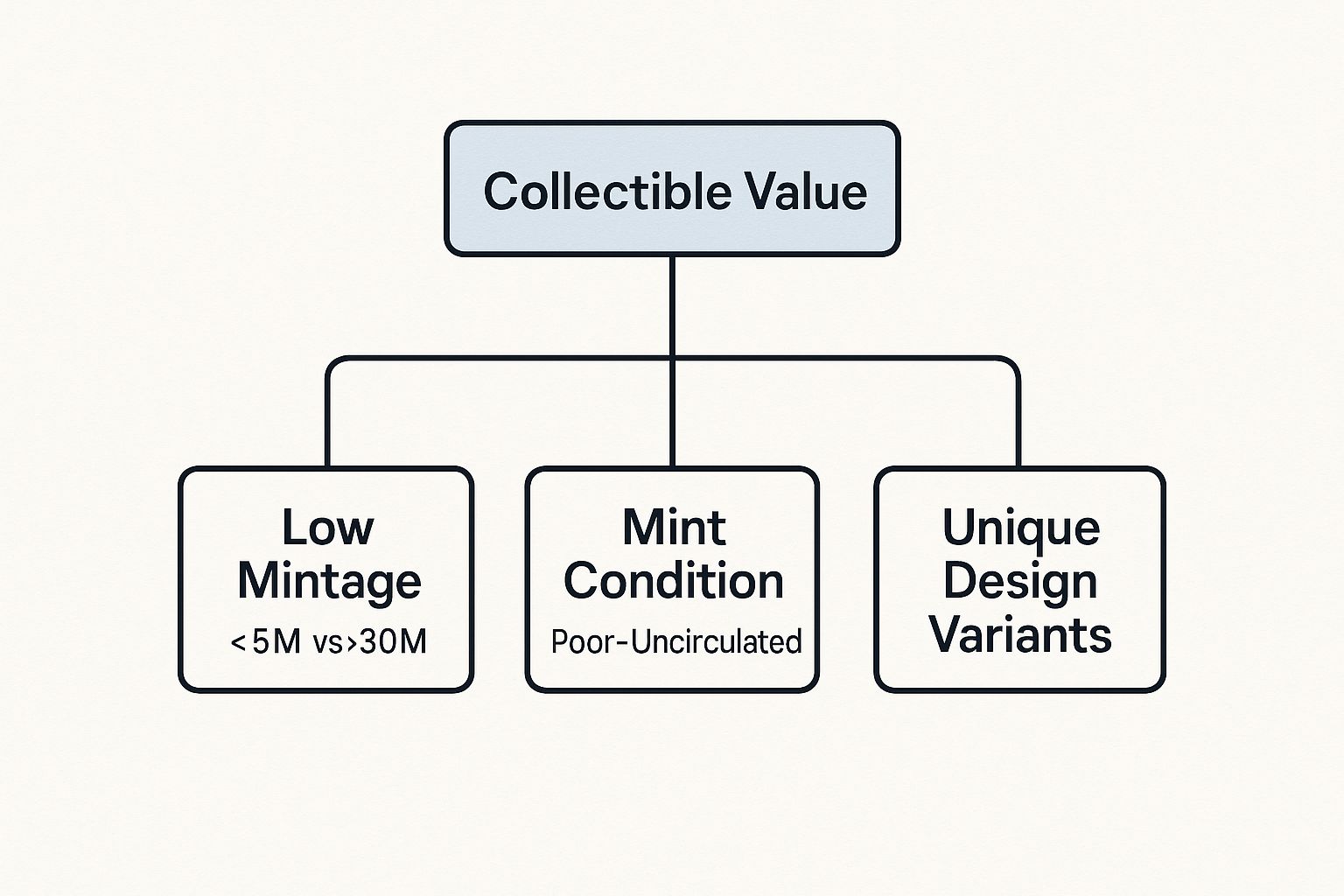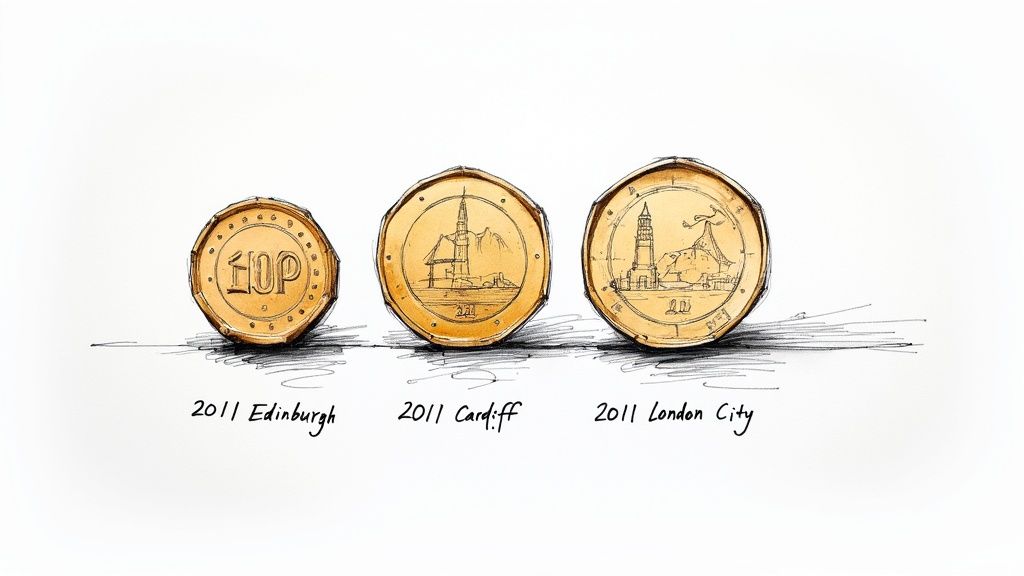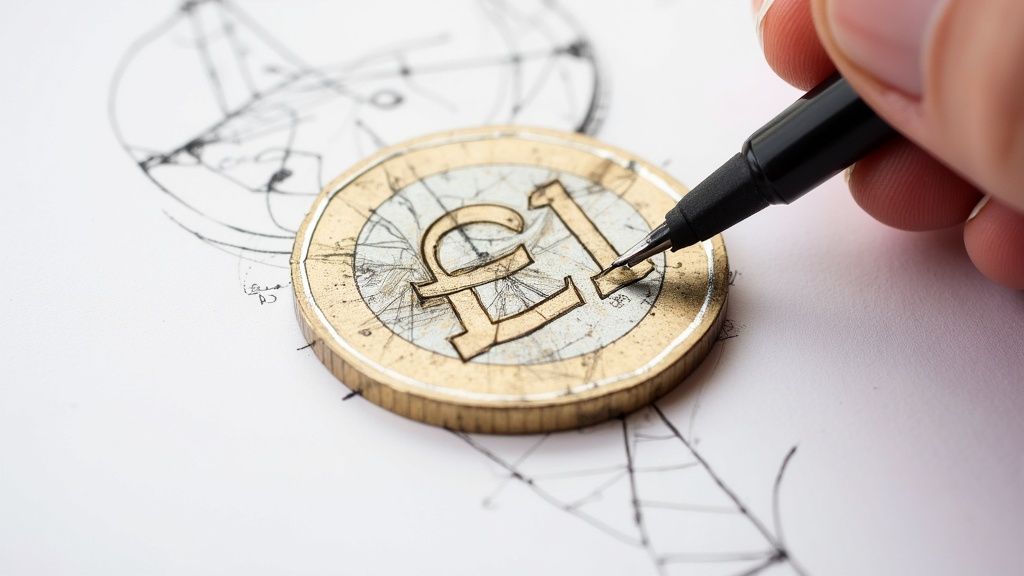Absolutely. Some one pound coins are worth money—a lot more than their face value, in fact. The rarest ones can fetch anywhere from a tenner to over £50. It all comes down to scarcity. Take the 2011 Edinburgh City £1 coin, for instance; with a mintage of under a million, it's a piece that collectors are always eager to find.
Your Pocket Change Could Be Worth More Than You Think

Ever found yourself staring at a pound coin, wondering if it might be a special one? You're certainly not alone. Most people just see a quid for what it is, but tucked away in change jars and wallets across the country are coins worth a whole lot more to a keen-eyed collector. Think of this guide as your treasure map.
We’re going to cut through the noise and show you exactly what makes certain £1 coins so valuable. It usually boils down to a couple of simple things: very low production runs or unique designs that slipped by unnoticed. Get ready to start looking at your change in a completely different way—you never know when you'll stumble upon a rare gem.
What Makes a Pound Coin Valuable?
Figuring out what separates a standard pound from a real find is the first hurdle. It’s a bit like a limited-edition book—the fewer copies printed, the more they’re worth down the line. It's the exact same story with coins. While The Royal Mint pumps out millions of coins every year, some designs or years have surprisingly tiny production numbers.
A coin's life story also plays a huge part in its value. A brilliant, uncirculated coin that looks like it just rolled off the press will always be worth more than one that’s been clanking around in pockets for a decade. Any damage, scratches, or general wear and tear will knock its value down in the eyes of a serious collector.
At its heart, what determines if you have one of the pound coins that are worth money is a mix of its rarity (low mintage), its physical condition, and the story behind its design.
This guide will give you the essential knowledge to start spotting these hidden treasures. We’ll be covering:
- Key Mintage Figures: Learn which years had the smallest production runs, making those coins instantly harder to find.
- Must-Have Designs: Discover the specific coin designs—from the classic round pound to the new 12-sided version—that collectors are hunting for right now.
- Condition and Value: Get to grips with how to judge a coin's condition and see how that directly affects what it’s worth on the market.
What Turns a Normal Pound Coin Into a Collectible
Ever wondered why one pound coin might be worth £15 while another is just, well, a pound? It’s not down to luck or magic. It all comes down to a few key details that separate the change in your pocket from a genuine collector's piece. Getting your head around these factors is the first step to spotting which one pound coins are worth money.
The biggest factor, by a country mile, is mintage. Think of mintage as the coin's 'production run' – it's simply the total number of a specific coin design that The Royal Mint produced in a particular year. When that number is low, you're automatically dealing with a scarcer coin.
For instance, a standard Royal Arms £1 coin from 2003 is common as muck, with a mintage of over 312 million. Compare that to the 2011 Edinburgh City £1 coin, which had a tiny mintage of just 935,000. With far fewer out there, the Edinburgh coin is much tougher to find, making it a prize for collectors.
Mintage and Condition: The Keys to Value
But scarcity isn't the whole story. A coin's physical condition is just as important, if not more so. A coin that’s spent years being bashed about in pockets, tills, and piggy banks will inevitably pick up scratches, dings, and general wear. All that damage massively reduces its appeal to a collector and, with it, its value.
On the flip side, an 'uncirculated' coin looks as fresh and crisp as the day it left the mint. Serious collectors will always pay a premium for a coin in top-notch condition. It’s like the difference between a dog-eared, well-loved paperback and a pristine, signed first edition—both tell the same story, but one is a whole lot more desirable.
This infographic breaks down what really drives a coin's value.

As you can see, low mintage figures, excellent condition, and interesting designs are the three pillars holding up a coin's value. Nail these concepts, and you're well on your way.
Ultimately, the sweet spot for a valuable find is a coin with a low mintage that has somehow survived in near-perfect condition. These are the rare treasures that turn pocket change into a genuine collectible.
A couple of other things can add a bit of extra value, too:
- Design Variants: Every now and then, small mistakes or differences happen during the minting process. These 'error coins' are often one-of-a-kind and can be highly sought after by specialists.
- Historical Significance: Coins that commemorate a special event or mark the end of an era (like the final round pound design) often carry a bit of extra historical weight, which can boost their appeal.
The Rarest Round Pound Coins to Watch For

Now you know what makes a coin rare, the real fun can begin. It's time to go on a treasure hunt.
The old round pound, which we used from 1983 right up to 2016, is a brilliant place to start. While most designs were churned out in their tens of millions, a handful had incredibly small production runs. These are the ones that have become the stars of any collection.
These are the specific one pound coins that are worth money, the ones you should be actively searching for in old coin jars, piggy banks, or forgotten drawers. Spotting one of these could turn a simple pound into a serious find. Let's shine a spotlight on the undisputed champions of rarity in the round pound world.
The Holy Grail: 2011 Edinburgh City
If there's one coin that tops every collector's wish list, it's the legendary 2011 Edinburgh City £1 coin. If you find only one rare round pound in your lifetime, you want it to be this one.
Its almost mythical status comes down to one simple fact: it is the only round pound design to ever have a mintage of less than one million.
This scarcity makes it the undisputed king. The Royal Mint only struck 935,000 of them, released as part of the Capital Cities series. This tiny number has sent its value soaring, with prices on the secondary market easily hitting ten times its face value, and sometimes much more if it's in top condition. You can find more great insights on the UK's rarest coins over at The Westminster Collection's blog.
To put its rarity into perspective, for every single Edinburgh coin minted in 2011, The Royal Mint produced over 40 Royal Arms £1 coins back in 1983. This extreme difference in production numbers is precisely why finding an Edinburgh coin is such a special moment for any collector.
Other Capital City Rarities
While the Edinburgh coin is the ultimate prize, it wasn't the only rarity to come out of the Capital Cities series. Its siblings from the same collection also boast impressively low mintage figures, making them hugely desirable finds for any enthusiast.
- 2011 Cardiff City: The second-rarest round pound, this coin features the circular Coat of Arms of Cardiff. With a mintage of just 1,615,000, it's far scarcer than most other designs and commands a strong price on the collectors' market.
- 2010 London City: Representing England's capital, the London City coin is the third rarest. It depicts the City of London's shield and had a mintage of 2,635,000. While more common than its Welsh and Scottish counterparts, it remains a key coin for any serious collection.
These three from the Capital Cities series are the top-tier rarities to hunt for. Finding any of them is a fantastic achievement and a real testament to a sharp eye. Always check the date and the design carefully – those are the details that separate a common pound from a collector's piece worth holding onto.
The Modern Twelve-Sided Pound Coins You're Looking For
When the new 12-sided £1 coin landed in our pockets back in 2017, it spelled the end for the classic round pound. A lot of collectors scrambled to find the last of the old rarities, but it's a huge mistake to ignore the new coins jingling in your change. The world of valuable pound coins didn't just stop; it turned a new page.
Just like their round predecessors, the value of these modern coins boils down to one simple thing: mintage figures. While billions of these new pounds have been struck, some years saw surprisingly small production runs. This scarcity creates instant collectibles for anyone with a keen eye. These are the modern one pound coins that are worth money, and they prove you can still find a bit of treasure in your everyday cash.
The Final Coin of a Historic Reign
If there's one modern coin every collector should be hunting for, it's the 2022-dated Nations of the Crown £1 coin. This isn't just another pound; it's a piece of British history. This was the very last £1 coin issued with the portrait of Queen Elizabeth II before her passing, making it a poignant symbol of her incredible reign.
But it's the scarcity that really sends its value soaring. In the entire history of UK £1 coins, the 2022 issue is a real standout, with just 7.735 million of these coins minted. This tiny production run makes the 2022-dated coin the rarest 12-sided £1 you can find in circulation. It’s the perfect storm of historical weight and low supply, and collectors have definitely taken notice. You can dive deeper into rare coin mintages at Cash 4 Coins.
This coin marks a clear end of an era in British money. As the nation transitioned from Queen Elizabeth II to King Charles III, the 2022 pound became a powerful and highly collectible piece of our numismatic story.
King Charles III Enters the Scene
The new Carolean era has, of course, brought its own coins to watch out for. The first £1 coins bearing the portrait of King Charles III arrived with fresh designs, and their initial mintage figures make them very interesting prospects for the future.
- The 2023 King Charles III 'Bee' £1: As the very first circulating £1 coin of the new King, this piece sparked a massive wave of excitement. Its initial low mintage figures made it a real challenge to find.
- The 2025 King Charles III 'Bee' £1: Subsequent releases are also being produced in much smaller numbers than the billions of QEII coins we're used to, making them essential additions for any modern collection.
For now, the 2022 Queen Elizabeth II coin holds the top spot as the rarest modern pound. But these early King Charles III coins are absolutely the ones to keep an eye on. As the years go by and more designs are released, the very first issues of this new reign will almost certainly become more and more sought-after.
Uncommon Designs and Surprising Sleepers
Beyond the big-name rarities that everyone talks about, the world of coin collecting has its hidden gems. These are the ‘sleeper’ coins—pieces that most people would spend without a second thought because their designs look so familiar. Learning to spot these is what really separates a casual enthusiast from a sharp-eyed collector.
It’s easy to get fixated on the obviously unique designs, but sometimes the real value is hiding in plain sight: the date stamped on a seemingly ordinary coin. A coin’s year can be every bit as important as its pattern. Training your eye to catch this detail is the key to finding those quiet rarities that others miss, turning what looks like common pocket change into a brilliant find.
The most rewarding discoveries often come from knowing what to look for beyond the obvious. A common design from a specific, low-production year can be more valuable than a visually striking coin that was minted in the millions.
This is exactly where you’ll find some of the most interesting one pound coins that are worth money. They don’t shout about their scarcity; they whisper it through their mintage figures.
The Royal Arms: A Year Makes All the Difference
A perfect example of a sleeper hit is the 2008 Royal Arms £1 coin. The Royal Arms shield is one of the most recognisable designs out there, having been used multiple times over the years. Because of this, most people would glance at it and dismiss it as just another common quid. But the 2008 version is a completely different beast.
While other minting years saw this design produced in the tens of millions, the 2008 issue had a surprisingly low mintage. That single detail elevates it from everyday currency to a genuinely sought-after collectible. It's a classic case of value hidden in plain sight, where a little bit of knowledge completely changes your perspective.
Overlooked and Undervalued Coins
The 2008 Royal Arms isn't the only coin that flies under the radar. Several other designs looked common when they first came out but have since become prized by collectors who know their true scarcity.
For instance, the 2008 Royal Arms and the 2010 London City £1 coins are now known to be among the rarest of the old round pounds, despite their familiar appearance. With a mintage of only around 3.9 million, the 2008 coin is the third rarest round £1 design. Likewise, the London City coin has become a key piece for collectors, with prices hitting up to £50 depending on its condition. You can find more insights on these surprising rarities at The Week.
This highlights a crucial lesson for any collector: always, always check the date. Sometimes, the most valuable finds aren’t just rare designs but rare production years of common ones. This knowledge also helps when spotting minting mistakes, and you can learn more if you check out our guide on how to discover valuable error coins. By looking past the obvious, you open up a whole new world of collecting possibilities.
How to Value Your Coins and Spot Fakes

Finding what you think might be a rare coin is a real buzz, isn't it? But that initial excitement is just the first step. The real work begins when you need to figure out its genuine value and, just as importantly, make sure it's the real deal.
This is where you move from being a lucky finder to a proper collector. Forget about what sellers are asking for online; those prices are often just wishful thinking. The only number that matters is what people are actually paying.
The most reliable way to get a feel for this is to head over to eBay and check the "sold" listings. Pop your coin's details into the search bar (something like "2011 Edinburgh pound coin") and then filter the results to show only the sold items. This gives you a live look at the market, based on real transactions, not inflated asking prices.
When you're trying to find which one pound coins are worth money, it's absolutely vital to evaluate information sources effectively to avoid getting led astray. Stick with hard sales data, and you’ll be working with facts, not fantasy.
Checking a Coin's Condition
The condition of a coin, what we call its 'grade', has a huge say in its final value. It’s no exaggeration to say that a pristine, uncirculated coin can be worth many times more than the exact same coin that's been rattling around in pockets and tills for years.
- Look for Sharp Details: A top-grade coin will have crisp, clear details. The Queen's portrait, the lettering, and all the design elements should look sharp and well-defined.
- Check for Scratches and Dings: Get the coin under a good light and look closely at its surfaces. Any major scratches, marks, or dents, especially across the main design, are going to bring its value down.
- Assess the Luster: An uncirculated coin often has a unique sort of shine, what collectors call 'mint luster'. If it looks dull, dirty, or grimy, that’s a sure sign it’s seen a lot of action.
A key lesson for new collectors is this: value is tied directly to how well a coin has been preserved. You’ll often find that a common coin in perfect condition is more sought-after than a genuinely rare coin in terrible shape.
How to Spot a Fake
Sadly, wherever there's value, you'll find fakes. The growing interest in rare coins has led to a flood of counterfeits onto the market, many of them designed to fool the inexperienced eye. But there are usually a few tell-tale signs.
Keep an eye out for lettering that looks a bit soft, 'mushy', or unevenly spaced. Genuine Royal Mint coins have sharp, perfectly formed inscriptions. The colour can also be a giveaway – fakes sometimes look a bit too shiny, or they might have an odd yellowish tint to them.
For a more in-depth look at the whole process, this excellent guide on how to value coins is a fantastic resource that covers grading in much more detail.
Common Questions from New Coin Collectors
Diving into the world of coin collecting is exciting, but it can feel a bit like learning a new language. Once you’ve sifted through your change and found a few interesting coins, the real questions start to pop up. Let's tackle some of the most common queries we hear from people just starting their journey.
So, where’s the best place to sell a rare pound coin you’ve found? For most people, online marketplaces like eBay or a dedicated Facebook group are your best bet. These platforms open your finds up to a huge audience of keen collectors. The trick is to look at the ‘sold’ listings, not the asking prices, to get a realistic idea of what people are actually paying. If you think you've stumbled upon something truly exceptional, however, speaking to a professional dealer could get you a much better price.
What to Do with Your Finds
One question comes up time and time again: should I clean my old coins before selling them? The answer is a simple and emphatic no. Never, ever clean them. Even the gentlest wipe can leave microscopic scratches or strip away the natural patina that has built up over years. Collectors prize originality, and any kind of cleaning will drastically reduce a coin's value in their eyes.
And what about those odd-looking coins? The ones that look a bit... wrong? Yes, error coins and trial pieces can be incredibly valuable. Coins with minting mistakes—like being struck off-centre or featuring mismatched dates—are often one-of-a-kind treasures. These 'misfits' are highly sought after and represent a fascinating corner of the hobby.
Learning the ropes is all part of the fun. Every question you ask builds your confidence and sharpens your eye, turning you from a casual searcher into a knowledgeable collector. For more guidance, you might be interested in our guide on how to start collecting coins.
At Cavalier Coins Ltd, we provide a vast selection of coins and banknotes for every level of enthusiast. Whether you're just starting or hunting for a rare piece, explore our collection at https://www.cavaliercoins.com.

